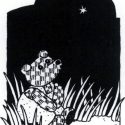Dea Trier Mørch was born in Copenhagen and was an author and an artist. She trained in graphic design, studying at the Painting School of the Royal Danish Academy of Fine Arts from 1958 to 1964 and continuing her studies at art academies in Warsaw, Krakow, Belgrade, Leningrad, and Prague from 1964 to 1967. As part of the artists’ commune Røde Mor (red mother), she participated in countless exhibitions and illustrated her own works as well as those of others.
In her intense debut work, an account of her travels and mental journeys, Sorgmunter socialism, 1968, illustrated with her own etchings, she reported on her travels to the Soviet Union. It is followed by the travel book Polen, 1970. Her international success Vinterbørn (1976; Eng. tr. Winter’s Child), translated into twenty-two languages and filmed in 1978 by Astrid Henning-Jensen, about a group of women giving birth at Rigshospitalet – Copenhagen University Hospital – was the first in a number of novels about the life of a modern and politically active person: Den indre by, 1980, Aftenstjernen (1982, Eng. tr. Evening Star), and Morgengaven, 1984.
Dea Trier Mørch’s novels and illustrations oscillate between perceptive, sensitive detail, the fragile self, and the larger entities of the family and political commitment. She returned to travel in her book Da jeg opdagede Amerika, 1986, while Landskab i to etager, 1992, is written in letter form and depicts the complicated love between two middle-aged characters. Hvide løgne, 1995, which she wrote together with her daughter Sara Trier, is shaped like a conversation between mother and daughter about growing up in a divorced family.


